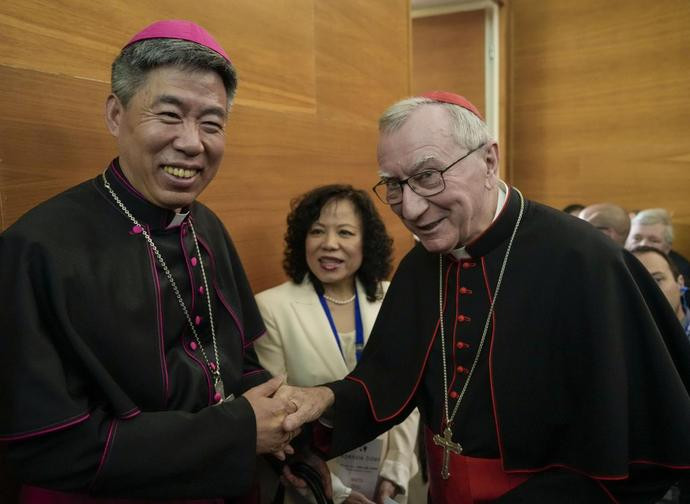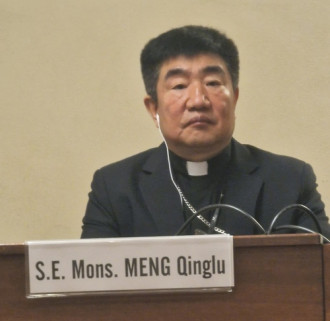China-Vatican, rewrites history to legitimise secret agreement
Many Chinese speakers, video-message by the Pope and speech by the Vatican Secretary of State, Card. Parolin: the Shanghai Council of 1924 commemorated with two conferences, one in Milan another in Rome, to promote "the spirit" of the secret agreement on the appointment of bishops. Forcing history on the backs of Chinese Catholics.

"We have been hoping for a long time now to be able to have a stable presence in China even if it might not at first have the form of a pontifical representation, of an apostolic nunciature...". It is in this perspective, as outlined in words by the Vatican Secretary of State, Cardinal Pietro Parolin, that the conference on the 100th anniversary of the Council of Shanghai, which Parolin also attended yesterday, 21 May, should be interpreted.
In reality, it was a commemoration in two stages: Monday 20th in Milan, organised by the Catholic University, and yesterday precisely in Rome, organised by the Pontifical Urbanian University; both were made possible by the Community of Sant'Egidio, which is doing it’s best to promote the 'spirit' of the controversial secret agreement between China and the Holy See, signed in 2018, renewed every two years and now about to be definitively approved.
 In both Milan and Rome there was a large Chinese presence among the speakers, all obviously linked to the communist regime in Beijing, bishops included: in Milan there was the Mongolian bishop of Hohhot, Meng Qinglu, who has taken part in several illegitimate episcopal ordinations; in Rome there was instead the bishop of Shanghai, Joseph Shen Bin, protagonist of the famous 'slap in the face' of the Communist regime to the Holy See: he was installed in Shanghai on 4 April 2023 by the government and the Pope, with his back to the wall, only recognised him on the following 15 July. That he is now speaking at a conference in the Vatican speaks volumes about the balance of power established by the agreement and above all about the Vatican's willingness to concede anything just to plant a flag in Beijing.
In both Milan and Rome there was a large Chinese presence among the speakers, all obviously linked to the communist regime in Beijing, bishops included: in Milan there was the Mongolian bishop of Hohhot, Meng Qinglu, who has taken part in several illegitimate episcopal ordinations; in Rome there was instead the bishop of Shanghai, Joseph Shen Bin, protagonist of the famous 'slap in the face' of the Communist regime to the Holy See: he was installed in Shanghai on 4 April 2023 by the government and the Pope, with his back to the wall, only recognised him on the following 15 July. That he is now speaking at a conference in the Vatican speaks volumes about the balance of power established by the agreement and above all about the Vatican's willingness to concede anything just to plant a flag in Beijing.
No wonder then that the memory of the Concilium Sinense in Shanghai (May-June 1924) was an opportunity to reinterpret history to suit current needs. But what was the Shanghai Council? Above all, it was the way in which the indications to the missionary world that Pope Benedict XV had given in his Apostolic Letter Maximum Illud (1919) began to be implemented in China: the pope noted that in various parts of the world, the missionary task was being held back by the excessive dependence of the clergy on the colonial powers that controlled those regions; hence, for example, the need to promote the creation of a 'perfectly formed' indigenous clergy: "Just as the Church of God is universal, and therefore by no means foreign to any people, so it is fitting that in each nation there should be priests capable of directing, as teachers and guides, their own countrymen on the path to eternal health".
Monsignor Celso Costantini, sent as apostolic delegate to China by Pope Pius XI at the end of 1922, was the great director of this journey, and already in 1926 there was the ordination in Rome of six Chinese bishops, a way of emphasising that the 'indigenisation' of the Church was closely linked to its universality.
The not too veiled attempt of the two celebratory conferences of these days is to create a parallel between that process of "nationalisation" and the current "Sinicisation" imposed by Chinese President Xi Jinping through the Patriotic Association of Chinese Catholics, and endorsed by the Vatican hierarchies. This is also demonstrated by a passage in Pope Francis' video-message to the Roman conference, when he said: "In Shanghai, the Fathers gathered in the Concilium Sinense lived an authentically synodal experience and took important decisions together. The Holy Spirit brought them together, made harmony grow among them, led them along paths that many among them would not have imagined, overcoming even perplexity and resistance. This is what the Holy Spirit who guides the Church does'. In practice, says the Pope, the Holy Spirit, through synodality, moved them from opposing the ordination of local clergy to opening up 'new paths'. In other words, that is what we are doing today; that those who criticise the agreement with China are not open to the Holy Spirit.
The parallel with the Shanghai Council, however, is an obvious historical over reach. Not only because of the political and social context of that time totally different from today's: China was still living in the turmoil that followed the republican revolution of 1911-12 that had overthrown the Qing dynasty, the First World War and the season of the warlords. A situation far removed from that of the current totalitarian regime that today controls the whole of China with an iron fist and tends to expand.
But above all, in the documents of Popes Benedict XV and Pius XI, in the work of Monsignor Costantini, in the actions of important Chinese Catholic figures of the time (also recalled in these conferences) it is clear that the only real concern was 'the proclamation of Christ'. It was the missionary impetus that drove to find the best ways to bring Christ to every man, to every people. There were no political calculations, but the missionaries were called back to their original vocation who "are not sent by their country, but by Christ". The process of indigenisation of the clergy, therefore, was the fruit of missionary zeal. Attending these conferences in Milan and Rome, on the other hand, there was a clear perception of the opposite path: to systematise the Church in such a way as to legitimise its 'nationalisation', but precisely in the sense desired by the communist regime. Essentially, all the speeches implied this objective.
There is a second very important aspect, to reveal the devious lie on which certain positions are based. Forcing the parallel between the Vatican's attitude today and that of the last century, one skips over everything that has happened in the last hundred years, and what is still happening today. The Chinese Church, however small in numbers, has given great proof of faith through martyrdom: since the advent of the communist regime in 1949 alone, thousands of Chinese Catholics have paid with their blood for belonging to Christ and their loyalty to the Pope. And they still pay for this belonging with systematic persecution, aggravated after the 2018 China-Holy See agreements. A persecution that has now also spread to Hong Kong, where there are dozens and dozens of Catholics in prison. It is the martyrdom and faithfulness of so many that proves that the Church has truly become Chinese; this is the true 'Sinicisation', which should continue to be pursued.
Instead, a tragic silence has descended on all this reality from the Vatican; in the two conferences on the Shanghai Council, it would have seemed to an unaware listener of the real situation that it should be the Church to amend itself of its sins against China. Because the unaware listener does not know that silence is the price to be paid for hoping to 'have a stable presence' in Beijing. At the expense of Chinese Catholics.
Photo: Bishop Shen Bin with cardinal Parolin, Agence La Presse
Vatican set to renew controversial agreement despite China’s betrayal
For Cardinal Parolin, Vatican Secretary of State, the secret agreement with China must be renewed. And this time it should be definitive. Nothing counts, neither Beijing's violations of the agreement nor the growing persecution of Catholics who resist kowtowing to the Party, including those in Hong Kong.
"Jimmy Lai, persecuted by China, abandoned by the Vatican"
As Hong Kong tightens its national security law, the famous Catholic dissident risks being jailed for life. Father Robert Sirico attended the last hearing of his trial: 'He saw me, I blessed him and he was moved'. A crucifix drawn in prison is now on display at the Catholic University of Washington. The closeness of Cardinal Zen, the silence of Rome and the Church in Hong Kong.


